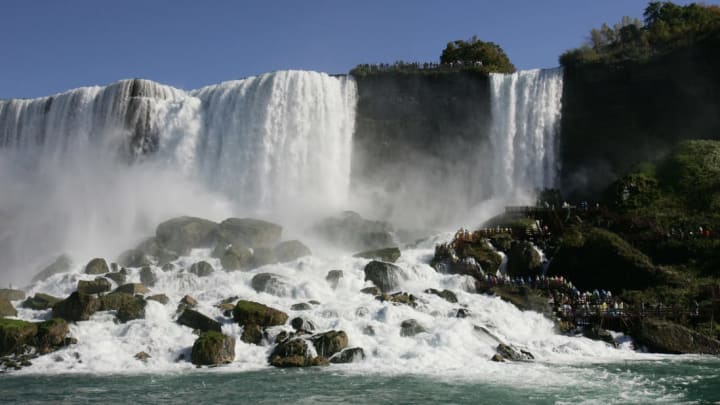When you want to stop Niagara Falls from flowing, install a cofferdam. The New York State Parks Commission is hoping to do just that as early as 2019.
At a public meeting yesterday, the commission discussed details of a proposal to build two new bridges to replace the existing structures, which date to the turn of the 20th century. The current bridges, which stretch from the mainland to Green Island and from Green Island to Goat Island, are in bad shape: They were temporarily closed in 2004 so that trusses could be installed to stabilize them and allow access to Goat Island, but pieces continue to fall into the water below.
The parks commission determined in 2015 that rehabilitation of the bridges wouldn’t be possible—both the initial construction methods (reinforced concrete with earth-filled arches) and extensive deterioration meant new bridges would be necessary. And to build new bridges, they’d have to dry up the American side of the Niagara River, which sends as much as 150,000 gallons of water per second over the American and Bridal Veil Falls.
To accomplish the dewatering, a temporary cofferdam would be installed, probably at the upstream end of Goat Island. It would stretch from the island—which sits at the edge of the falls and divides the American side from Canada’s Horseshoe Falls—over to the mainland and divert flow from the river entirely to the Canadian side. (Only 15 percent of the falls flow to the American side; 85 percent gushes toward Canada.)
Once the area is dry, the project could proceed in one of two ways. In the first, the Falls would be water-less from August to December. During that time, the existing structures would be demolished and workers would install piers, according to ABC News Buffalo; water flow would begin again at the end of December, and the next year, workers would resume construction on the bridges. The process would be completed in two years. The second option, which would last a year, would require a nine-month dewatering starting in April and round-the-clock construction.
The commission has been looking at rehabilitating or replacing the bridges since 2009, but the project doesn’t yet have funding and isn’t approved. It estimates that construction costs will range from $21.37 million to $37.32 million, depending on the design chosen, and notes that the state parks department "will need to secure special capital funding from state and/or federal sources prior to advancing this project to the construction phase."
If it does move forward, the work will begin in 2019. It will be the second time the American side of the falls has stopped flowing thanks to humans: In 1969, the U.S. Army Corps of Engineers diverted the flow of the river to the Canadian side using a 600-foot cofferdam constructed of 27,800 tons of rock. The goal? To study the accumulation of boulders and rock from rock slides at the bottom of the falls. The dried-up falls drew many tourists, and after six months of investigation, a decision was made to leave the falls as they were. The cofferdam was removed in November of that year.
You can read the full PDF report of the proposal here.
